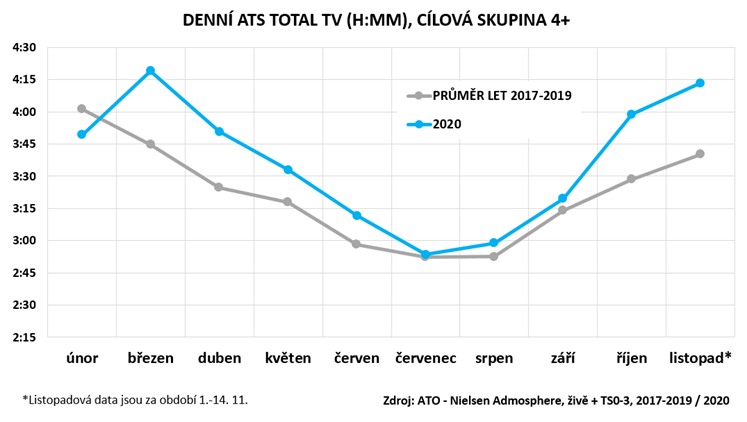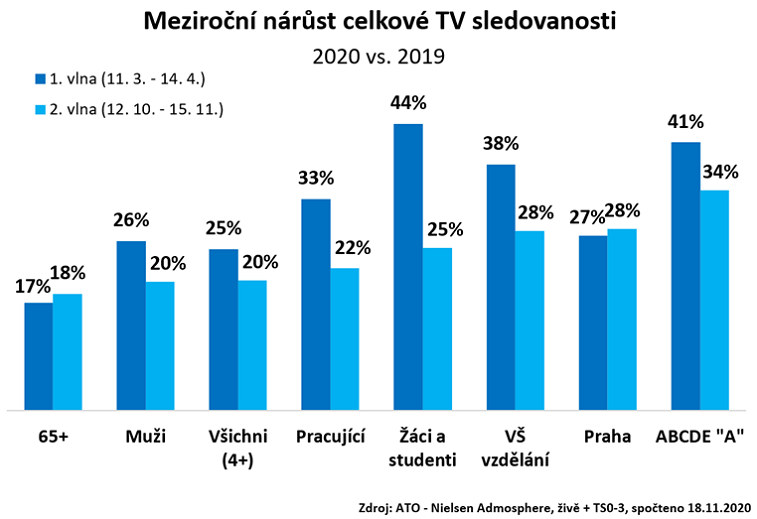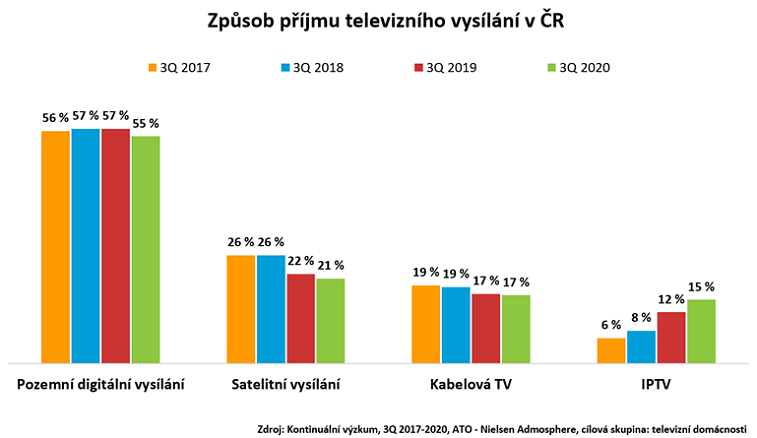The daily ATS in the 15+ target group accounted for 4 hours and 18 minutes this October, which is 35 minutes more compared to the average values for the same month in the last three years.
The Covid-19 pandemic thus confirmed the role of TV as a significant source of information and the way of leisure time spending. Namely in certain months of the year, ATS in the 4+ viewer group achieved very high values compared to the average for the prior three years. “Undoubtedly, this is caused by the coronavirus pandemic which locks us down in our homes where TV is our natural companion and results in a great hunger for information. And TV provides a wealth of information, especially in the times of crisis,” says Tereza Šimečková, Chairwoman of the Board of Directors of Nielsen Admosphere, commenting on the results. In terms of ATS, October 2020 has become the strongest of all months of October since the people meter measuring in 1997.
DAILY ATS TOTAL TV (H:MM), TARGET GROUP 4+
 2017-2019 AVERAGE February – March – April – May – June – July – August – September – October – November* *November data is from 1 to 14 November Source: ATO – Nielsen Admosphere, live+TS0-3, 2017-2019 / 2020 Source: ATO-Nielsen Admosphere
2017-2019 AVERAGE February – March – April – May – June – July – August – September – October – November* *November data is from 1 to 14 November Source: ATO – Nielsen Admosphere, live+TS0-3, 2017-2019 / 2020 Source: ATO-Nielsen AdmosphereDuring the spring wave, the 4+ group grew by a quarter while during the autumn wave by 20%. In certain groups of population, the growth was more significant than in other groups: in spring, during the first state of emergency, the increase was high among pupils and students (+44%), the top “A” group within the ABCDE socio-economic classification (+41%), people with university education (+38%) or economically active (working) viewers (+33%). During the autumn wave, ATS has grown significantly (albeit with a smaller year-on-year change than in spring) in group “A” within the ABCDE socio-economic classification (+34%), among viewers from Prague (+28%) and people with university education (+28%); the group of pupils and students saw an increase of a quarter (+25%).
Year-on-year growth in the total TV rating
1st wave
2nd wave
 65+ Men All (4+) Working people Pupils and students University education Prague ABCDE “A” Source: ATO-Nielsen Admosphere, live + TS0-3, calculated on 18 November 2020
65+ Men All (4+) Working people Pupils and students University education Prague ABCDE “A” Source: ATO-Nielsen Admosphere, live + TS0-3, calculated on 18 November 2020Thanks to the current developments in technology and changes in viewing habits, time shifted viewing, i.e. viewing programmes after their live broadcasting, has been growing for a long time. This viewing option has already been provided to households by cable and namely IPTV operators or new types of smart TVs having the HbbTV function (hybrid TVs, the so-called “red button”). This year, viewers in the 15+ target group watched 22 minutes of TV broadcasting per day with a time shift (0-7 days), which is an increase of 8 minutes year on year.
The continuous research data indicates how the method of receiving TV broadcasts has changed in Czech households over the years – including the period of the last year when people had to solve transition to DVB-T2. At present (according to the results for August and September 2020), 55% of households receive TV stations through terrestrial digital broadcasting, which continues to be the prevailing method of TV reception in the Czech Republic. Households prefer it to the satellite (21%), cable (17%) and IPTV (15%) reception. In general, satellite and cable reception tends to decline slowly over the years while IPTV, i.e. digital TV distributed through the Internet, slightly increases.
Method of TV broadcast reception in the Czech Republic
 Terrestrial digital broadcasting Satellite broadcasting Cable TV IPTV Source: Continuous research, 3Q 2017-2020, ATO – Nielsen Admosphere, target group: TV households Source: ATO-Nielsen Amdopshere
Terrestrial digital broadcasting Satellite broadcasting Cable TV IPTV Source: Continuous research, 3Q 2017-2020, ATO – Nielsen Admosphere, target group: TV households Source: ATO-Nielsen Amdopshere“The unprecedented growth in TV viewing and the completion of the transition to the higher technological standard of DVB-T2 are undoubtedly two extraordinary aspects to be mentioned at the occasion of this year’s World Television Day,”
said Vlasta Roškotová, Managing Director of the Association of Television Organisations (ATO). The World Television Day is on 21 November.
Source: mediaguru.cz

